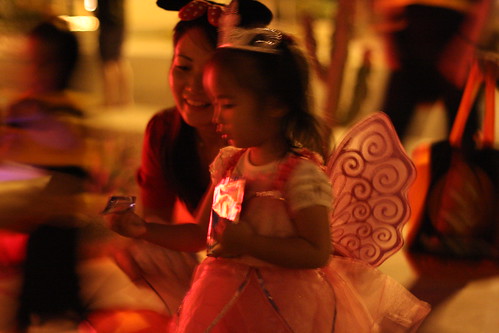
“Halloween on Harrison Court” by Kevin Dooley from Flickr
Today, I’m happy to share a very timely guest post by Amy Patterson.
Halloween poses some unique challenges for kids with diabetes. Halloween is about many things: costumes, ghost stories, jack-o-lanterns, and late-night fun with friends. It’s also about candy. Lots of candy. Kids, costumes, and candy. If your child is diabetic, that last item will pose a problem.
If your child has diabetes, you’re likely familiar with the hazards of candy. Pure sugar with nothing else to balance it out. Halloween is probably the most intense celebration of candy in the United States these days. Halloween is also a wonderful night for children, giving them a chance to get outside in the night with friends, dress up in wild costumes, and generally celebrate their imagination.
So what’s a parent to do? You don’t want your kid to miss out on a special night with friends. You don’t want your kid to be alienated by the neighborhood kids. You don’t want your kid to feel like diabetes makes her feel like an outsider. You do, though, want your kid to learn to manage diabetes at an early age. Here are some basic tips that you, as a parent, can take to ensure your child’s Halloween is safe AND fun this year.
Communicate Ahead of Time
Speak with your child about his condition ahead of time. Speak clearly about proper diabetes care, stressing the concrete dangers of hyperglycemia. He’ll understand your concern, learn self-dependence, and be thrilled to earn your respect by getting the opportunity to take care of himself. Plan ahead. If you’re comfortable with this, tell him he can bring home anything he wants, as long as he waits until coming home to eat. This will ensure you can observe what exactly he eats on Halloween. Also, this plan will allow your child to have a normal, fun Halloween with the neighborhood kids.
Trick or Treat With Your Kid
If you would rather have a hands-on Halloween experience with your child, go along for the ride! This will allow you to observe your child as she has safe, spooky fun. You can build memories, speak about pedestrian safety, and get an interesting perspective on her imagination. You’ll have fun and get to make sure you see what your kid eats. Remember that diabetic care be difficult for a child, both intellectually—it can be difficult to understand what the proper care actually consists of—and as a matter of willpower. Throwing off her blood sugar may make it more difficult to treat her; and improper use of diabetes meds is a common reason for emergency room visits. Your presence as a parent can help her with understanding as well as keeping her on task.
Ration the Night’s Find
After you’ve gathered the sweet, precious hoard, gather it up and organize portions. As a parent of a child with diabetes, you’re aware of your kid’s blood sugar and eating patterns. Diabetic children can, of course, eat sweets. But diabetic children, even more than other children, need to be careful. Rationing candy can help your child keep track of her sweets. This will also allow her to eventually eat all of that good candy WITHOUT overindulging. Wrapped candy can last a long time, after all. You could even make your Halloween harvest the entire year’s candy ration, doling it out in small doses when the occasion calls for it.
Amy Patterson is an avid reader on trending topics and a writer in her spare time. On the beautiful coast of North Carolina you will usually find her catching up on the latest news with locals or on the beach. She loves to write pieces on health, fitness, and wellness, but often writes about families and safety.
